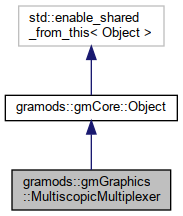The multiscopic multiplexing is the process of rendering images for the left and the right (or more) eyes in a format that can be physically or optically separated at a later stage so that these images are visible only to the correct eye. More...
#include <MultiscopicMultiplexer.hh>


Public Member Functions | |
| virtual size_t | getEyeCount ()=0 |
| Returns the number of eyes that should be rendered for the multiplexer. | |
| virtual void | prepare ()=0 |
| Prepares the multiplexer for rendering to the two eyes. | |
| virtual void | setupRendering (size_t eye)=0 |
| Sets up rendering for one eye at a time. | |
| virtual void | finalize ()=0 |
| Finalizes the multiplexing. | |
| virtual std::string | getDefaultKey () override |
| Returns the default key, in Configuration, for the Object. | |
 Public Member Functions inherited from gramods::gmCore::Object Public Member Functions inherited from gramods::gmCore::Object | |
| Object () | |
| Initializes internal data. | |
| virtual | ~Object () |
| Cleaning up internal data. | |
| virtual void | initialize () |
| Called to initialize the Object. | |
| virtual void | accept (Visitor *visitor) |
| Calls the visitors apply method with this as argument. | |
| virtual void | traverse (Visitor *visitor) |
| Calls the child Object's accept method, if such exist. | |
| bool | isInitialized () |
| Returns true if the Object is initialized. | |
Detailed Description
The multiscopic multiplexing is the process of rendering images for the left and the right (or more) eyes in a format that can be physically or optically separated at a later stage so that these images are visible only to the correct eye.
Examples are sequential frame multiplex, split screen or pixel interlaced multiplexing, and anaglyphic color multiplexing.
A MultiscopicView will for each frame call, in order,
- prepare()
- N = getEyeCount()
- setupRendering(0)
- ...
- setupRendering(N-1)
- finalize()
Member Function Documentation
◆ finalize()
|
pure virtual |
Finalizes the multiplexing.
Implemented in gramods::gmGraphics::InterlaceMultiplexer, gramods::gmGraphics::LinearAnaglyphsMultiplexer, gramods::gmGraphics::QuadBufferMultiplexer, and gramods::gmGraphics::SideBySideMultiplexer.
◆ getDefaultKey()
|
inlineoverridevirtual |
Returns the default key, in Configuration, for the Object.
Reimplemented from gramods::gmCore::Object.
◆ getEyeCount()
|
pure virtual |
Returns the number of eyes that should be rendered for the multiplexer.
Most multiplexers are stereoscopic and will therefore return two (2).
Implemented in gramods::gmGraphics::InterlaceMultiplexer, gramods::gmGraphics::LinearAnaglyphsMultiplexer, gramods::gmGraphics::QuadBufferMultiplexer, and gramods::gmGraphics::SideBySideMultiplexer.
◆ prepare()
|
pure virtual |
Prepares the multiplexer for rendering to the two eyes.
Implemented in gramods::gmGraphics::InterlaceMultiplexer, gramods::gmGraphics::LinearAnaglyphsMultiplexer, gramods::gmGraphics::QuadBufferMultiplexer, and gramods::gmGraphics::SideBySideMultiplexer.
◆ setupRendering()
|
pure virtual |
Sets up rendering for one eye at a time.
Implemented in gramods::gmGraphics::InterlaceMultiplexer, gramods::gmGraphics::LinearAnaglyphsMultiplexer, gramods::gmGraphics::QuadBufferMultiplexer, and gramods::gmGraphics::SideBySideMultiplexer.
The documentation for this class was generated from the following file:
- /home/karlu/private/program/gramods/modules/gmGraphics/include/gmGraphics/MultiscopicMultiplexer.hh